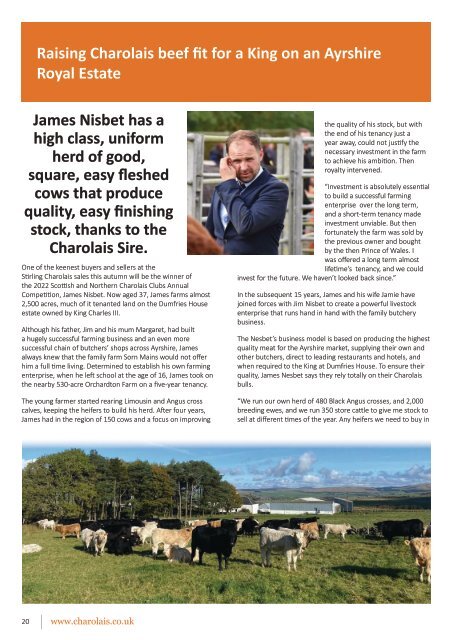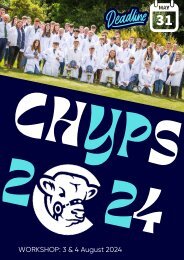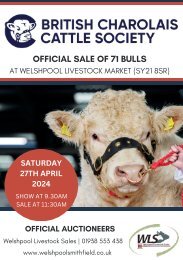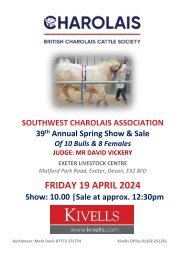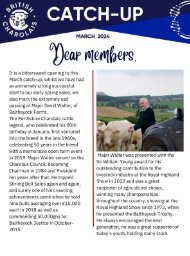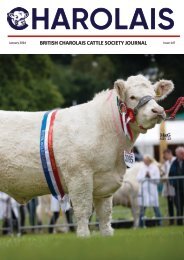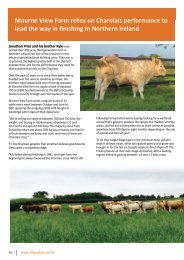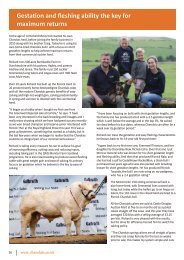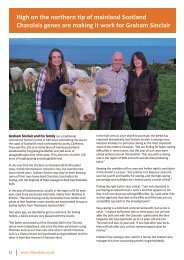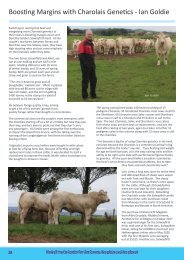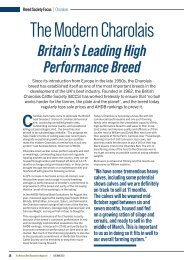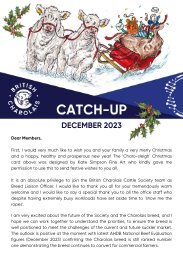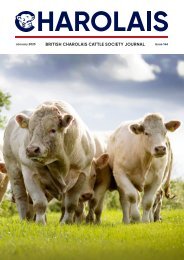Why James Nisbet thanks the Charolais sire for quality, easy finishing stock!
February 2024
February 2024
- No tags were found...
Create successful ePaper yourself
Turn your PDF publications into a flip-book with our unique Google optimized e-Paper software.
Raising <strong>Charolais</strong> beef fit <strong>for</strong> a King on an Ayrshire<br />
Royal Estate<br />
<strong>James</strong> <strong>Nisbet</strong> has a<br />
high class, uni<strong>for</strong>m<br />
herd of good,<br />
square, <strong>easy</strong> fleshed<br />
cows that produce<br />
<strong>quality</strong>, <strong>easy</strong> <strong>finishing</strong><br />
<strong>stock</strong>, <strong>thanks</strong> to <strong>the</strong><br />
<strong>Charolais</strong> Sire.<br />
One of <strong>the</strong> keenest buyers and sellers at <strong>the</strong><br />
Stirling <strong>Charolais</strong> sales this autumn will be <strong>the</strong> winner of<br />
<strong>the</strong> 2022 Scottish and Nor<strong>the</strong>rn <strong>Charolais</strong> Clubs Annual<br />
Competition, <strong>James</strong> <strong>Nisbet</strong>. Now aged 37, <strong>James</strong> farms almost<br />
2,500 acres, much of it tenanted land on <strong>the</strong> Dumfries House<br />
estate owned by King Charles III.<br />
Although his fa<strong>the</strong>r, Jim and his mum Margaret, had built<br />
a hugely successful farming business and an even more<br />
successful chain of butchers’ shops across Ayrshire, <strong>James</strong><br />
always knew that <strong>the</strong> family farm Sorn Mains would not offer<br />
him a full time living. Determined to establish his own farming<br />
enterprise, when he left school at <strong>the</strong> age of 16, <strong>James</strong> took on<br />
<strong>the</strong> nearby 530-acre Orchardton Farm on a five-year tenancy.<br />
The young farmer started rearing Limousin and Angus cross<br />
calves, keeping <strong>the</strong> heifers to build his herd. After four years,<br />
<strong>James</strong> had in <strong>the</strong> region of 150 cows and a focus on improving<br />
<strong>the</strong> <strong>quality</strong> of his <strong>stock</strong>, but with<br />
<strong>the</strong> end of his tenancy just a<br />
year away, could not justify <strong>the</strong><br />
necessary investment in <strong>the</strong> farm<br />
to achieve his ambition. Then<br />
royalty intervened.<br />
“Investment is absolutely essential<br />
to build a successful farming<br />
enterprise over <strong>the</strong> long term,<br />
and a short-term tenancy made<br />
investment unviable. But <strong>the</strong>n<br />
<strong>for</strong>tunately <strong>the</strong> farm was sold by<br />
<strong>the</strong> previous owner and bought<br />
by <strong>the</strong> <strong>the</strong>n Prince of Wales. I<br />
was offered a long term almost<br />
lifetime’s tenancy, and we could<br />
invest <strong>for</strong> <strong>the</strong> future. We haven’t looked back since.”<br />
In <strong>the</strong> subsequent 15 years, <strong>James</strong> and his wife Jamie have<br />
joined <strong>for</strong>ces with Jim <strong>Nisbet</strong> to create a powerful live<strong>stock</strong><br />
enterprise that runs hand in hand with <strong>the</strong> family butchery<br />
business.<br />
The Nesbet’s business model is based on producing <strong>the</strong> highest<br />
<strong>quality</strong> meat <strong>for</strong> <strong>the</strong> Ayrshire market, supplying <strong>the</strong>ir own and<br />
o<strong>the</strong>r butchers, direct to leading restaurants and hotels, and<br />
when required to <strong>the</strong> King at Dumfries House. To ensure <strong>the</strong>ir<br />
<strong>quality</strong>, <strong>James</strong> Nesbet says <strong>the</strong>y rely totally on <strong>the</strong>ir <strong>Charolais</strong><br />
bulls.<br />
“We run our own herd of 480 Black Angus crosses, and 2,000<br />
breeding ewes, and we run 350 store cattle to give me <strong>stock</strong> to<br />
sell at different times of <strong>the</strong> year. Any heifers we need to buy in<br />
20<br />
www.charolais.co.uk
come from Anthony Birkett near Duns.<br />
“I have always put my cows to <strong>the</strong> <strong>Charolais</strong>, however, until two<br />
years ago I was putting my heifers to Angus bulls. But after a<br />
couple of difficult breeding years, I changed my breeding policy<br />
and switched back to <strong>Charolais</strong>. They’ve done an excellent job<br />
<strong>for</strong> us. There has been such an improvement in <strong>Charolais</strong> bulls<br />
in recent times and <strong>the</strong>y are now much easier to calve, have<br />
a much better temperament, and importantly <strong>for</strong> me <strong>the</strong>y are<br />
producing <strong>the</strong> highest <strong>quality</strong> progeny.”<br />
<strong>James</strong> usually purchases two or three bulls at <strong>the</strong> Stirling sales,<br />
favouring <strong>the</strong> <strong>stock</strong>y Harestone, Midlock or Carwood pedigrees:<br />
“I personally don’t use EBV measurements, I rely on my own<br />
eyes looking specifically <strong>for</strong> a smaller, thicker type of bull, as<br />
this is what suits our model best. I do not want a massive bull,<br />
because I want to sell calves which are short, bulky, and <strong>easy</strong><br />
fleshed. The cut-off now is 400 kilos deadweight, so we want<br />
to produce a <strong>Charolais</strong> to 600 kilos as opposed to 800 kilos in<br />
<strong>the</strong> past.<br />
“We put about 90 heifers to <strong>the</strong> bull <strong>for</strong> six weeks, and average<br />
83 heifers in-calf. We keep cows up to ten years old, and 410<br />
are put to <strong>the</strong> bulls, left <strong>for</strong> 11 weeks, and we expect 390 to<br />
be in calf. Calves are born March, April and May, and weaned<br />
October, November, December when <strong>the</strong>y’re over 350 Kilos.”<br />
All cattle are outside all summer, and everything is brought<br />
in at <strong>the</strong> end of October. When <strong>the</strong>y’re weaned, <strong>the</strong>y go into<br />
straw bedded pens and fed concentrate through calf creeps, a<br />
feeding blend of barley, grains, and beet pulp along with home<br />
grown silage.<br />
Once weaned, <strong>James</strong> will expect his calves to achieve <strong>the</strong> kind<br />
of market-leading net weight gain that keeps <strong>the</strong> <strong>Charolais</strong> at<br />
<strong>the</strong> top of <strong>the</strong> EBV rankings. “I would think that our calves are<br />
putting on 1.7 to 1.8 kilos quite com<strong>for</strong>tably a day, and I know<br />
<strong>the</strong>y go on to do well <strong>for</strong> <strong>the</strong> finishers.”<br />
The Nesbets will sell in <strong>the</strong> region of 450 calves each year,<br />
starting on <strong>the</strong> first Wednesday in January at <strong>the</strong> United<br />
Auctions mart in Stirling, selling every Wednesday <strong>the</strong>reafter<br />
www.charolais.co.uk 21
until <strong>the</strong> end of March. Heifer calves are sold at an average<br />
weight of 380 kilos and bullocks between 420 to 480 kilos, an<br />
average of 450. This year bullocks have sold to an averaged of<br />
£1,200 and heifers just over £1,000, both just slightly ahead of<br />
last year.<br />
“I sell to finishers from Scotland and <strong>the</strong> North of England, who<br />
will keep <strong>the</strong>m to finish in <strong>the</strong> region of 650 kilos. We have a<br />
strong following of customers, and I know which cattle to take<br />
to <strong>the</strong> market to meet <strong>the</strong> needs of <strong>the</strong> individual buyers.”<br />
point of view <strong>the</strong> cows are here to look after you as opposed to<br />
you looking after <strong>the</strong>m and that is exactly what our herd here<br />
does.”<br />
But like any live<strong>stock</strong> farmer and breeder, <strong>James</strong> Nesbet wants<br />
his cattle to look <strong>the</strong> best, and even his landlord thinks he<br />
has good-looking cows on his estate, which is <strong>the</strong> ultimate<br />
compliment, coming from The King.<br />
Clearly <strong>the</strong> commercial success of <strong>the</strong> farming and related<br />
butchery business is crucial to <strong>the</strong> <strong>Nisbet</strong>’s future, but <strong>James</strong><br />
Nesbet is also proud of <strong>the</strong> family’s reputation <strong>for</strong> <strong>quality</strong>, both<br />
<strong>for</strong> <strong>the</strong>ir meat, and <strong>for</strong> <strong>the</strong>ir herd.<br />
“The primary aim is to produce first class meat, and we must<br />
produce what <strong>the</strong> consumer wants at an af<strong>for</strong>dable price,<br />
which makes <strong>the</strong> <strong>Charolais</strong>’ fast weight gain and <strong>finishing</strong> all <strong>the</strong><br />
more important. We’re proud of what we have achieved, and<br />
very grateful to everyone who buys our <strong>stock</strong> every year.”<br />
“During <strong>the</strong> last 15 years we have tried to build up a high class,<br />
uni<strong>for</strong>m herd of good, square, <strong>easy</strong> fleshed cows that produce<br />
<strong>quality</strong>, <strong>easy</strong> <strong>finishing</strong> <strong>stock</strong>. From a practical and commercial<br />
22<br />
www.charolais.co.uk


